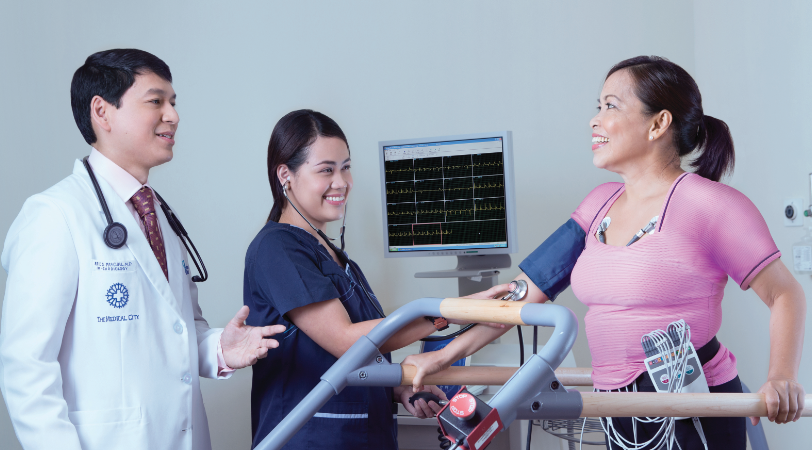Cardiac and Peripheral Vascular Laboratory
2nd Flr., Podium Building, The Medical City, Ortigas Ave. Pasig City
Operating Hours: Mon – Sat / 8 AM to 5 PM; Sunday and Holidays / 8 AM – 5 PM (but no special procedure)
8-988-1000/8-988-7000 ext. 6299
PATIENT SERVICES
Precise Cardiovascular Diagnostic
The Medical City's cardio diagnostic procedures exemplify the institution's commitment to cutting-edge technology and precise evaluations. With a focus on early detection and accurate diagnosis, the institute offers a wide array of state-of-the-art tests and screenings to assess cardiovascular health comprehensively. From electrocardiograms and stress tests to echocardiography and advanced imaging modalities, our cardio diagnostic in the Philippines are carried out by experienced specialists with unwavering attention to detail. The collaborative effort between skilled cardiologists and cutting-edge equipment ensures swift and accurate results, empowering clinicians to tailor individualized treatment plans, ultimately leading to improved patient outcomes and enhanced heart health.

Our Cardio Diagnostic Procedures
1. Coronary Angiogram and Left Heart Catheterization
A fluoroscopy-guided procedure is performed by inserting diagnostic catheters into either the groin artery or the forearm artery (under local anesthesia). By injecting a radio-opaque contrast medium, the arteries supplying blood to the heart are visualized. This enables the determination of the severity and quantity of narrowings (stenoses) that may potentially lead to a heart attack.
The procedure is also known as coronary angiography and coronary artery catheterization. It helps visualize blood flow through the arteries of the left ventricle, detect any blockages or narrowing in its vessels, measure pressures within the left ventricle and identify any aneurysms.
It is typically used to diagnose coronary heart disease (CHD), chest pain, palpitations, heart valve problems, and congenital heart conditions. It can also be used to assess the effectiveness of treatments for CHD, as well as guide further therapies such as angioplasty and stenting of narrowed coronary arteries.
2. Hemodynamic Studies/Right Heart Catheterization
The procedure involves the insertion of a specialized catheter known as the Swan Ganz catheter into the right side of the heart. This is done under fluoroscopy guidance to gather crucial data on pressures and flow, which helps in assessing and defining cardiac function.
The procedure is used to diagnose pulmonary hypertension, assess the efficacy of medical therapies for heart failure, guide transcatheter intervention in certain congenital heart diseases, and identify abnormal hemodynamic states such as that caused by aortic dissection.
3. Intravascular Ultrasound (IVUS)
IVUS provides a view of the artery from within the artery itself, using ultrasound-capable miniature catheters, thereby making diagnosis much more accurate, and cardiac interventions, like the insertion of stents to relieve artery blockages, easier and more precise.
IVUS is used to assess the size and shape of a coronary artery, as well as to measure any plaque deposits that have accumulated within it. It can be used in conjunction with other catheter-based procedures such as angioplasty and stenting.
4. Fraction Flow Reserve (FFR) Analyzer
FFR measurements play a crucial role in identifying lesions that impede blood flow to the heart. They serve as a reliable guide, helping determine whether a borderline narrowing should be treated with a stenting procedure. By optimizing precision and accuracy, FFR measurements assist in making informed decisions for the best course of action.
The FFR measurement is done by simultaneously measuring the pressure in the aorta as well as within the coronary artery at rest and during increased flow, such as via adenosine administration or exercise testing. It can be utilized for guiding revascularization of atherosclerotic lesions in the coronary arteries.
5. Electrophysiological Studies (EPS)
Electrophysiological studies (EPS) play a crucial role in the diagnosis of potentially hazardous heart rhythm irregularities. By conducting EPS, cardiologists can devise personalized treatment plans utilizing medications or procedures like Radio Frequency Ablation or the implantation of an Implantable Cardioversion-Defibrillation device. These interventions aim to effectively manage and mitigate future risks associated with cardiac health.
The EPS procedure involves the insertion of catheters into different parts of the heart to measure electrical signals (i.e., depolarization and repolarization). This helps in understanding which areas are causing arrhythmias, as well as how they can be treated. The procedure also enables cardiologists to identify any potentially dangerous conditions that could lead to sudden cardiac death.
EPS has a wide range of applications in the management of arrhythmias, including but not limited to atrial fibrillation (AFib), supraventricular tachycardia (SVT), ventricular tachycardia (VT), and bradyarrhythmias. It can be used for diagnosing and guiding treatments for ventricular arrhythmias and evaluating the efficacy of antiarrhythmic drug therapy.
How Often Should You Get Checked?
The frequency of cardio diagnostic in the Philippines depends on several factors, such as age, pre-existing medical conditions, family history, lifestyle, etc. It is recommended that individuals over the age of 40 years should have regular checkups with their physician or cardiologist every 1-2 years. This may include comprehensive physical examinations as well as specific tests such as ECG, echocardiography, and coronary angiography.